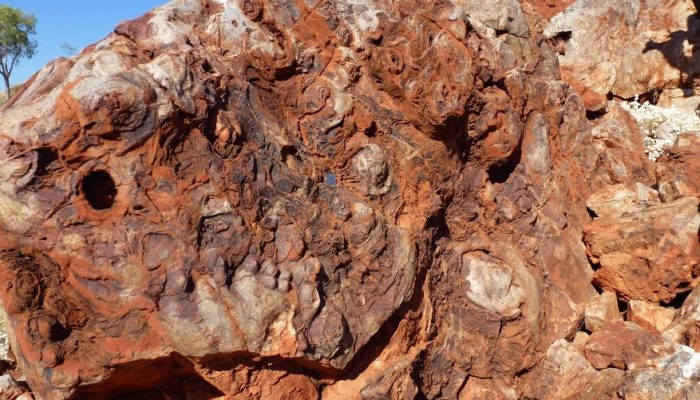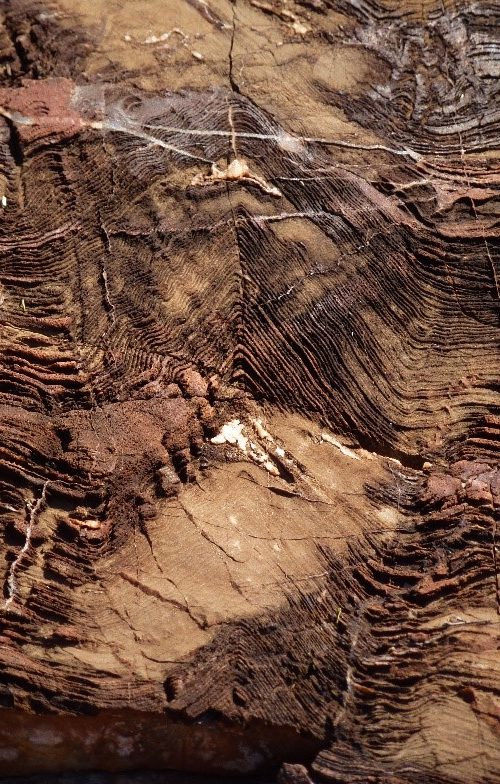
This is a solicited blogpost written by Sebastian Viehmann.
The Mesoarchean Strelley Pool Formation in the Pilbara Craton (Western Australia) hosts one of the oldest geological remnants of life on Earth. These silicified stromatolitic carbonates show diverse morphologies and formed on a shallow marine carbonate platform 3.35 billion years ago (Ga; Figures 1 and 2). After a long-standing debate about the biogenicity of these stromatolites starting in the 1980s, sedimentary features of the stromatolites are nowadays accepted as clearly pointing to the presence of microbial life. The ancient stromatolites from the Strelley Pool Formation thus allow us to reconstruct the palaeo-environments of one of the oldest microbial habitats on Earth.
However, the genetic history of the predominant occurring mineral phases in the stromatolites such as carbonates (dolomite) and silica (microcrystalline quartz; chert) is still not well understood. Thus, it is questionable how reliable they are as geochemical archives of the atmosphere-hydrosphere system of the time when microbial life was thriving and developing in the shallow marine Strelley Pool habitat.
My colleagues and I applied trace element and radiogenic Nd isotopes to both carbonate and quartz phases of the Strelley Pool succession to directly date both mineral phases and investigate their genetic history. Individual layers of stromatolitic carbonates plot on a Sm-Nd regression line yielding 3.253 ± 0.320 Ga. This calculated age matches within the error with the deposition age of the Strelley Pool Formation, but also overlaps with a thermal event that triggered the eruption of the 3.2 Ga Sulfur Springs Group. This suggests that the Nd isotope composition in stromatolitic carbonates is pristine or was modified within 200 million years after carbonate formation. In contrast, associated non-stromatolitic carbonates yield 2.718 ± 0.220 Ga. This implies a reset of the Sm-Nd isotope system during severe eruption events at the time of deposition of the lower Fortescue Group, which built up a massive volcanic province related to crustal extension and accompanied by extensive mafic dyke swarms some 2.7 billion years ago. The cherts plot far off Sm-Nd regression lines, but re-calculated initial Nd isotope compositions suggest that at earliest pervasive fluids of a mid-Proterozoic event could have altered the Sm-Nd isotope system in these cherts. A candidate for this is a widespread thermal event that affected most parts of the Pilbara Craton between 2.2 and 2.1 Ga. Trace element compositions in both stromatolitic and non-stromatolitic carbonates, however, are unaltered and show that both types of carbonates were formed – in accordance with earlier studies (e.g., van Kranendonk et al., 2003; Allwood et al., 2006) – in seawater. White cherts also preserved seawater-like trace element compositions during silicification and recrystallization processes and, hence, can be used as a reliable archive of ancient seawater. In contrast, black cherts incorporated significant amounts of elements leached by fluids from the surrounding rocks that masked the trace element composition of ancient Strelley Pool seawater.
In conclusion, trace element and Nd isotope data obtained within this study of the EU project ELEMIN match well with the reconstructed depositional environment based on lithological, geochemical, and stratigraphic relationships, on an early continent, showing at least episodic emergence above the sea level, supporting microbial life on a shallow marine platform.

Figure 2: Silicified stromatolitic carbonates of the 3.35 Ga old Strelley Pool Formation at the Trendall locality; vertical cut showing the internal structure with individual laminae of stromatolites (photo courtesy of S. Viehmann).
Original article:
Viehmann S., Reitner J., Tepe N., Hohl, S.V., Van Kranendonk, M., Hofmann, T., Koeberl, C., Meister, P., 2020: Carbonates and cherts as archives of seawater chemistry and habitability on a carbonate platform 3.35 Ga ago: Insights from Sm/Nd dating and trace element analysis from the Strelley Pool Formation, Western Australia. Precambrian Research 344, 105742. https://doi.org/10.1016/j.precamres.2020.105742

Figure 3: Modern stromatolites of the hypersaline Shark Bay lagoon, Australia (www.sharkbay.org.au).
The appearance of life on Earth is thought to be manifested in the geological record by stromatolites in the 3.49 Ga old Dresser and the 3.35 Ga old Strelley Pool Formations, Pilbara, Australia (Figures 1 & 2) that may be exemplary for potential microbial life on other planets. The term ‘stromatolite’ originates from pioneering work of Kalkowsky in 1908 and describes “organo-sedimentary structures formed by the incidental induction of mineral precipitation within or on microbial biofilms with, or without, trapping and binding of ambient sediments” (Webb & Kamber 2010 modified from Awramik and Margulis, 1974). The exact carbonate formation process(es) remain unknown; however, biogenic and/ or abiotic precipitation of carbonate that directly taps the chemical composition of the ambient fluid has been suggested to be responsible for carbonate formation within different levels of microbial mats. Stromatolites occur throughout Earth history and can even be found in modern extreme settings such as the hypersaline lagoon in Shark Bay, Australia (Figure 3). Stromatolitic carbonates, thus, provide unique geochemical insights into the evolution of life on Earth and the habitats in which microbial life thrived and evolved.
References:
Allwood A.C., Walter M.R., Kamber B.S., Marshall C.P., Burch I.W., 2006. Stromatolite reef from the Early Archaean era of Australia. Nature 441, 714-718.
Awramik S.M., Margulis L., 1974: Definition of stromatolite. Stromatolite Newsl. 2, 1-5.
Kalkowsky E., 1908: Oolith und Stromatolith im norddeutschen Buntsandstein. Zeitschrift der Deutschen Geologischen Gesellschaft 60, 68-125.
van Kranendonk M.J., Webb G.E., Kamber B.S., 2003: Geological and trace element evidence for a marine sedimentary environment of deposition and biogenicity of 3.45 Ga stromatolitic carbonates in the Pilbara Craton, and support for a reducing Archaean ocean. Geobiology 1, 91-108.
Webb G.E., Kamber B.S., 2010: Trace element geochemistry as a tool for interpreting microbialites. In: Golding S.D., Gilkson M. (Eds.) Earliest Life on Earth: Habitats, Environments and Methods of Detection.
Author:
Sebastian Viehmann obtained his PhD from the Jacobs University Bremen, Germany, he then joined the University of Vienna with a European Union MSCA-funded project (ELEMIN) on the earliest life on Earth and is now a senior research fellow at the Department of Geodynamics and Sedimentology, University of Vienna. His research applies stable and radiogenic isotope systems as well as trace element geochemistry to marine chemical sediments such as banded iron formations (BIFs) and carbonates to investigate the evolution of the Precambrian atmosphere-hydrosphere systems and the geodynamical evolution of early Earth.
